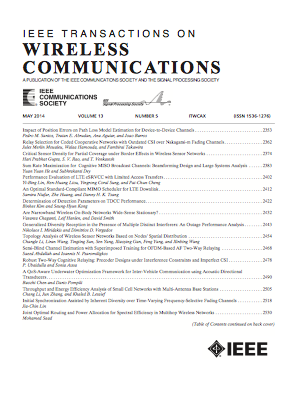反射图构建:加强和加快室内定位
IF 10.7
1区 计算机科学
Q1 ENGINEERING, ELECTRICAL & ELECTRONIC
引用次数: 0
摘要
本文介绍了一种利用环境中固定反射物,利用基站(BS)或具有到达角(AoA)和到达时间(ToA)测量能力的用户进行室内定位的方法。本地化过程包括两个阶段。在离线阶段,使用特定的策略识别特定区域内的有效反射点。在在线阶段,基于BS测量和离线阶段收集的信息,解决了最大化定位用户的问题。通过分析和仿真结果表明,在训练点数量相同的情况下,所提出的定位技术的性能优于基于指纹的定位技术。此外,我们表明,定位未知用户不需要在整个环境中使用大量的训练点;将这些训练点放置在环境的边界上就足够了。我们引入了反射率参数($n_{r}$),它量化了从发射机到接收机的一阶反射路径的平均数量,并展示了它对定位精度的影响。对数尺度正确率($R_{a}$)定义为定位面积除以定位模糊面积的对数函数,作为精度指标。我们表明,在信噪比(SNR)接近无穷大且没有视线(LoS)链路的情况下,$R_{a}$的上界为$n_{r} \log _{2}\left ({{1 + \frac {\mathrm {Vol}({\mathcal {S}}_{A})}{\mathrm {Vol}({\mathcal {S}}_{\epsilon }({\mathcal {M}}_{s}))}}}\right)$,其中$\mathrm {Vol}({\mathcal {S}}_{A})$和$\mathrm {Vol}({\mathcal {S}}_{\epsilon }({\mathcal {M}}_{s}))$分别表示定位区域的区域和包含所有反射点的区域,概率至少为$1 - \epsilon $。本文章由计算机程序翻译,如有差异,请以英文原文为准。
Reflection Map Construction: Enhancing and Speeding Up Indoor Localization
This paper introduces an indoor localization method that utilizes fixed reflector objects within the environment, leveraging a base station (BS) or users equipped with Angle of Arrival (AoA) and Time of Arrival (ToA) measurement capabilities. The localization process consists of two phases. In the offline phase, using specific strategy effective reflector points within a specific region are identified. In the online phase, a maximization problem is solved to locate users based on BS measurements and information gathered during the offline phase. Through analysis and simulation results, we demonstrate that with the same number of training points, the performance of the proposed localization technique surpasses that of fingerprint-based techniques. Additionally, we show that localizing an unknown user does not require a large number of training points throughout the entire environment; it is sufficient to place these training points on the boundary of the environment. We introduce the reflectivity parameter ( $n_{r}$ ), which quantifies the average number of first-order reflection paths from the transmitter to the receiver, and demonstrate its impact on localization accuracy. The log-scale accuracy ratio ( $R_{a}$ ) is defined as the logarithmic function of the localization area divided by the localization ambiguity area, serving as an indicator of accuracy. We show that in scenarios where the Signal-to-Noise Ratio (SNR) approaches infinity, and without a line of sight (LoS) link, $R_{a}$ is upper-bounded by $n_{r} \log _{2}\left ({{1 + \frac {\mathrm {Vol}({\mathcal {S}}_{A})}{\mathrm {Vol}({\mathcal {S}}_{\epsilon }({\mathcal {M}}_{s}))}}}\right)$ , where $\mathrm {Vol}({\mathcal {S}}_{A})$ and $\mathrm {Vol}({\mathcal {S}}_{\epsilon }({\mathcal {M}}_{s}))$ represent the areas of the localization region and the area containing all reflector points with a probability of at least $1 - \epsilon $ , respectively.
求助全文
通过发布文献求助,成功后即可免费获取论文全文。
去求助
来源期刊
CiteScore
18.60
自引率
10.60%
发文量
708
审稿时长
5.6 months
期刊介绍:
The IEEE Transactions on Wireless Communications is a prestigious publication that showcases cutting-edge advancements in wireless communications. It welcomes both theoretical and practical contributions in various areas. The scope of the Transactions encompasses a wide range of topics, including modulation and coding, detection and estimation, propagation and channel characterization, and diversity techniques. The journal also emphasizes the physical and link layer communication aspects of network architectures and protocols.
The journal is open to papers on specific topics or non-traditional topics related to specific application areas. This includes simulation tools and methodologies, orthogonal frequency division multiplexing, MIMO systems, and wireless over optical technologies.
Overall, the IEEE Transactions on Wireless Communications serves as a platform for high-quality manuscripts that push the boundaries of wireless communications and contribute to advancements in the field.

 求助内容:
求助内容: 应助结果提醒方式:
应助结果提醒方式:


